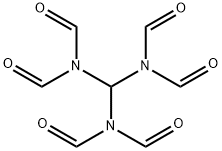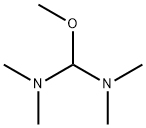TRIS(DIMETHYLAMINO)METHANE
- CAS NO.:5762-56-1
- Empirical Formula: C7H19N3
- Molecular Weight: 145.25
- MDL number: MFCD00008322
- EINECS: 227-284-0
- SAFETY DATA SHEET (SDS)
- Update Date: 2023-04-23 13:52:06

What is TRIS(DIMETHYLAMINO)METHANE?
Chemical properties
Clear colorless to slightly yellow liquid
The Uses of TRIS(DIMETHYLAMINO)METHANE
Tris(dimethylamino)methane was used:
- to prepare the phosphoramidite derivative of the new nucleoside analog
- as reagent for the introduction of the dimethylaminoethylidene group
- in ring-opening (RO) polymerization of lactide
The Uses of TRIS(DIMETHYLAMINO)METHANE
Reagent for the introduction of the dimethylaminoethylidene group.1 General review;2 RO polymerization of lactide.3
The Uses of TRIS(DIMETHYLAMINO)METHANE
N,N,N'',N'',N'''',N''''-Hexamethylmethanetriamine, can be used in the synthesis of the phosphoramidite derivative of the new nucleoside analog. It can also be used as reagent for the introduction of the dimethylaminoethylidene group.
General Description
NMR spectra and their temperature-dependence has been reported for tris(dimethylamino)methane. Tris(dimethylamino)methane reacts with crowded α-(o-nitrophenyl) ketone to yield tetrahydroquinoline derivative.
Purification Methods
Dry it over KOH and distil it through a Vigreux column (p 11) at water pump vacuum. Store it in the absence of CO2. [Bredereck et al. Chem Ber 101 1885 1968 and Angew Chem, Int Ed Engl 5 132 1966.]
Properties of TRIS(DIMETHYLAMINO)METHANE
| Boiling point: | 42-43 °C/12 mmHg (lit.) |
| Density | 0.838 g/mL at 20 °C (lit.) |
| refractive index | n |
| Flash point: | 4 °F |
| storage temp. | 2-8°C |
| form | Liquid |
| pka | 6.50±0.38(Predicted) |
| color | Clear colorless to slightly yellow |
| BRN | 1901162 |
Safety information for TRIS(DIMETHYLAMINO)METHANE
| Signal word | Danger |
| Pictogram(s) |
 Flame Flammables GHS02  Corrosion Corrosives GHS05 |
| GHS Hazard Statements |
H225:Flammable liquids H314:Skin corrosion/irritation |
| Precautionary Statement Codes |
P210:Keep away from heat/sparks/open flames/hot surfaces. — No smoking. P233:Keep container tightly closed. P240:Ground/bond container and receiving equipment. P280:Wear protective gloves/protective clothing/eye protection/face protection. P303+P361+P353:IF ON SKIN (or hair): Remove/Take off Immediately all contaminated clothing. Rinse SKIN with water/shower. P305+P351+P338:IF IN EYES: Rinse cautiously with water for several minutes. Remove contact lenses, if present and easy to do. Continuerinsing. |
Computed Descriptors for TRIS(DIMETHYLAMINO)METHANE
New Products
Tert-butyl bis(2-chloroethyl)carbamate (S)-3-Aminobutanenitrile hydrochloride N-Boc-D-alaninol N-BOC-D/L-ALANINOL 3-(2,4-Dimethoxybenzyl)dihydropyrimidine-2,4(1H,3H)-dione 7-Bromo-1H-indazole N-octanoyl benzotriazole 3,4-Dibenzyloxybenzaldehyde 4-Hydrazinobenzoic acid Electrolytic Iron Powder Fmoc-Val-Cit-PAB 1,1’-CARBONYLDIIMIDAZOLE R-2-BENZYLOXY PROPIONIC ACID 4-HYDROXY BENZYL ALCOHOL 1,1’-CARBONYLDI (1,2-4 TRIAZOLE) S-2-CHLORO PROPIONIC ACID (2-Hydroxyphenyl)acetonitrile 4-Bromopyrazole 5-BROMO-2CYANO PYRIDINE 5,6-Dimethoxyindanone 5-broMo-2-chloro-N-cyclopentylpyriMidin-4-aMine 1-(4-Methylphenylsulfonyl)-1H-1,2,3-benzotriazole 1-(2-Chlorobenzyl)-4-nitro-1H-pyrazole 1-(2-Nitrophenyl)-4-phenylpiperazineRelated products of tetrahydrofuran






You may like
-
 Tris(dimethylamino) methane, 96%+ CAS 5762-56-1View Details
Tris(dimethylamino) methane, 96%+ CAS 5762-56-1View Details
5762-56-1 -
 Tris(dimethylamino)methane (stabilized with KOH) CAS 5762-56-1View Details
Tris(dimethylamino)methane (stabilized with KOH) CAS 5762-56-1View Details
5762-56-1 -
 Tris(dimethylamino)methane 95% CAS 5762-56-1View Details
Tris(dimethylamino)methane 95% CAS 5762-56-1View Details
5762-56-1 -
 Tris(dimethylamino)Methane CHEMICAL GRADE CAS 5762-56-1View Details
Tris(dimethylamino)Methane CHEMICAL GRADE CAS 5762-56-1View Details
5762-56-1 -
 1446013-08-6 Fmoc-His-Aib-OH TFA 98%View Details
1446013-08-6 Fmoc-His-Aib-OH TFA 98%View Details
1446013-08-6 -
 127464-43-1 99%View Details
127464-43-1 99%View Details
127464-43-1 -
 2-ETHYLPYRIDINE 100-71-0 99%View Details
2-ETHYLPYRIDINE 100-71-0 99%View Details
100-71-0 -
 13162-05-5 99%View Details
13162-05-5 99%View Details
13162-05-5